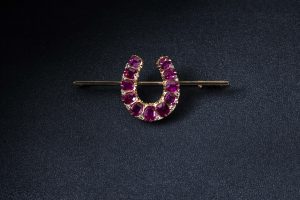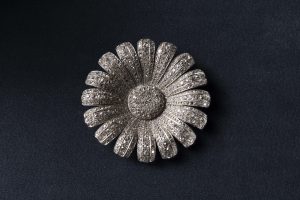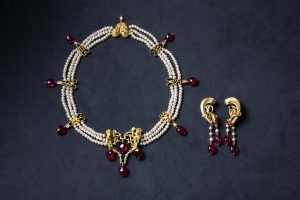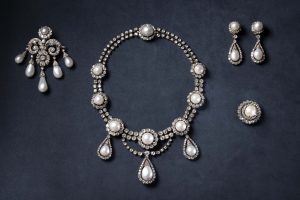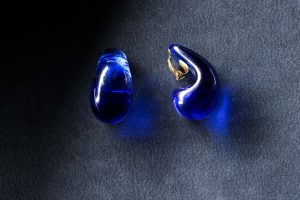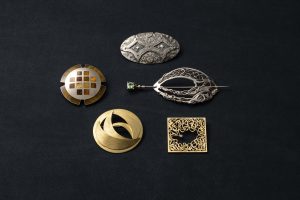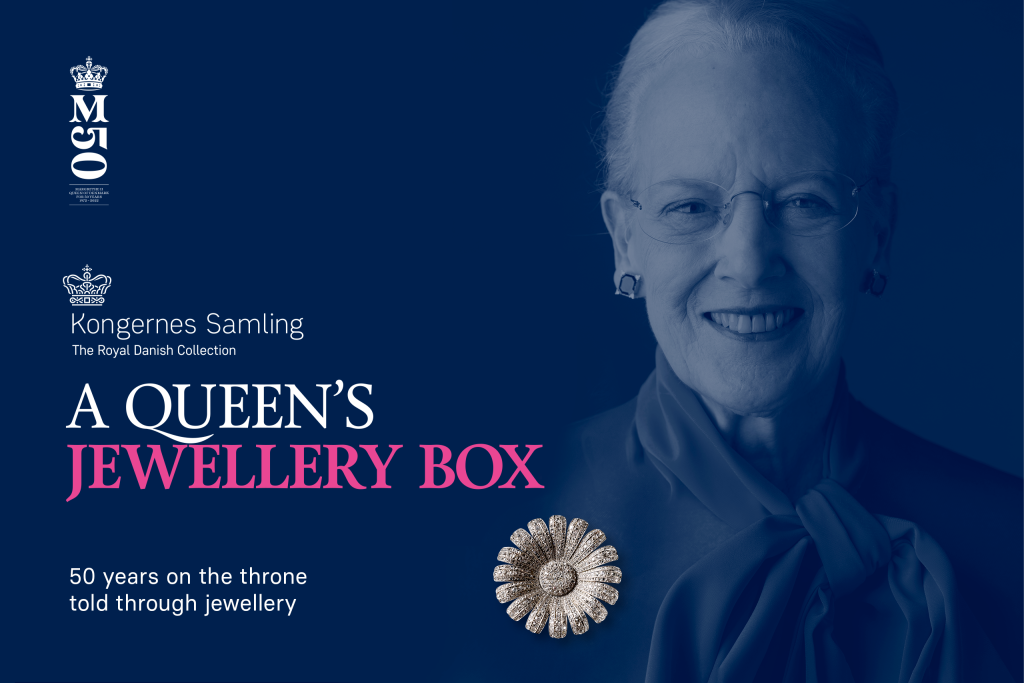
Selected pieces of jewellery
Horseshoe brooch
One of the items in the exhibition is the brooch the Queen wore when her ascension to the throne was announced on the balcony at Christiansborg Palace on 15 January 1972, the day after the death of Frederik IX. The brooch, which is in the shape of a horseshoe, was a gift to Princess Margrethe from her father, Frederik IX, in 1953, after he had signed the revised Constitution that made her his successor.
Daisy brooch
Another iconic piece is the Daisy brooch, which is a gift from Queen Ingrid on Queen Margrethe’s 60th birthday in 2000. Queen Ingrid had been given the brooch in connection with her wedding in 1935 as a gift from her father, the later King Gustaf VI Adolf of Sweden. She had lent it to Princess Margrethe for her wedding to Prince Henrik in 1967. The many diamonds in the brooch previously belonged to Queen Ingrid’s mother, Crown Princess Margareta of Sweden, who had passed away in 1920, at just 38 years of age. In the family, Margareta was called ‘Daisy’, a reference to Margaret/marguerite, and both the name and the pet name were passed on to the granddaughter. The Queen wears the Daisy brooch for special family events, most recently at Prince Christian’s confirmation in the chapel at Fredensborg Palace on 15 May 2021.
Silver wedding gift
Prince Henrik gave his wife many beautiful gifts, often jewellery created by Danish goldsmiths or acquired on travels abroad. A particularly beautiful example is the gift he gave the Queen for the couple’s silver wedding anniversary in 1992. On commission from the Prince, the Danish goldsmith Torben Hardenberg created this beautiful and symbolically charged three-strand pearl necklace with rubies and small gold figures.
The Pearl Poire set
The Queen has access to a large collection of historic jewellery that has been passed on in the family. The collection is secured in the Danish Royal Property Trust, which was established in 1910. The Queen has exclusive right of disposal and use of the pieces in the trust, including the Pearl Poire set, which is worn at important official events. The jewellery set, which may be regarded as the Queen’s signature jewellery, was brought to Denmark by the Swedish-Norwegian Princess Lovisa, who married Crown Prince Frederik (VIII) in 1869. It is an imposing set consisting of a tiara, a necklace, earrings and two brooches and is named after the large pear-shaped pearls. Today, the pieces are considered a set, although they were not originally designed as such. For example, the necklace was a gift to Lovisa in connection with her wedding to Crown Prince Frederik. The Pearl Poire set is probably the most frequently used sets of the many that are at the Queen’s disposal. As the crown jewels cannot leave the country, she often wears it at important events abroad, including at the wedding of Crown Princess Victoria of Sweden in 2010.
Plastic earrings
Not all the pieces in the exhibition feature imposing pearls, rubies, diamonds, sapphires or other precious stones. The Queen has many pieces of jewellery that she wears because of their colour. Many of them were purchased by the Queen herself on travels or longer stays – for example on her summer holiday in the town of Gråsten in southern Jutland, where the Queen spotted a pair of large deep-blue plastic earrings in a local Matas chemist shop. The plastic earrings are also included in the exhibition.
Local jewellery
The exhibition also shows many of the pieces of jewellery that the Queen has received from organizations, institutions and municipalities in connection with visits round the country, birthdays or anniversaries. The jewellery is contemporary, has a local story and is often made by local artists. Among them is this Fyrkat brooch, which is a gift from a visit to the town of Hobro in northern Jutland. It is made in the image of the Viking Age fortress Fyrkat and is accompanied by a set of earrings symbolizing the other Danish Viking Age ring fortresses.
For inquiries about the use of press photos, please contact Head of Communications Nanna Ebert:
Email: ne@kosa.dk. Tel.: +45 5133 6644
 Dansk
Dansk
 English
English
 Deutsch
Deutsch

